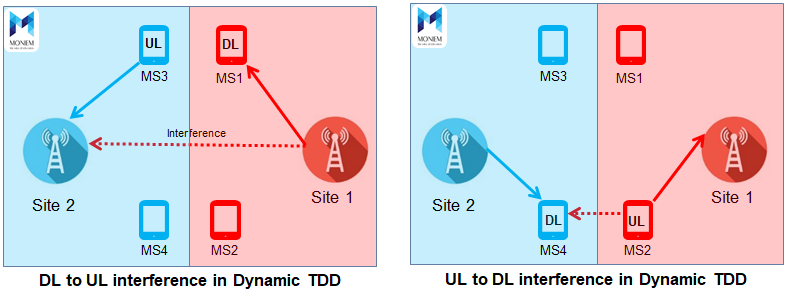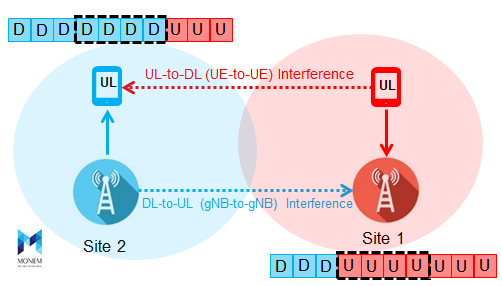Duplexing is one of the most important factors that impact the performance of 5G networks in terms of its wide-area coverage. 5G NR gives support to multiple duplex modes, that includes static TDD, FDD, and flexible duplexing.
It is expected that 3.5GHz TDD is the first spectrum for early 5G deployments.
Static TDD, the UL/DL traffic ratio is decided by the statistical UL/DL traffic load ratio.
With the increase of video streaming, it is likely that the proportion of DL content will grow, so more resources should be allocated to the DL. Therefore, a smaller proportion of the resources is left for the UL, which will affect the UL coverage performance.
In Static-TDD, transmission and reception of data occur at the same frequency band, through allocating distinct time slots for UL and DL. Moreover, the transmission bandwidth of each one of the links is fixed depending on the average traffic load.
Example:
Consider a simple setup consisting of two sites. Each site is having two MSs within its coverage area;
one of the MSs is requesting a DL, while the other MS is requesting a UL.
In Static TDD, there will be a DL time slot where only DL MSs are served and a UL time slot where only UL MSs are served.
This way, Static TDD will always avoid the interference between DL and UL.

According to the instantaneous traffic load, Dynamic TDD allows adjustments of uplink (UL) and downlink (DL) resources flexibly. Through allocating unique time slots for UL and DL just like S-TDD, the radio nodes can send and receive data on the same frequency band. However, with Dynamic TDD, the DL and the UL bandwidths vary according to the instantaneous traffic load.
In Dynamic TDD enables efficient and flexible asymmetric services, which improves the spectral efficiency of wireless networks. Nevertheless, Dynamic TDD induces interference between DL and UL.

So dynamic TDD adds additional cross-link interference that may degrade the system performance.
Basically, there are two types of interference associated with the dynamic TDD operation, UL-to-DL interference and DL-to-UL interference. 
For the 5G system, dynamic TDD is one of the proposed solutions for high data rate and low access delay. However, There’s another promising technology that I will discuss in the next article is called In-Band Full Duplex (IBFD).
